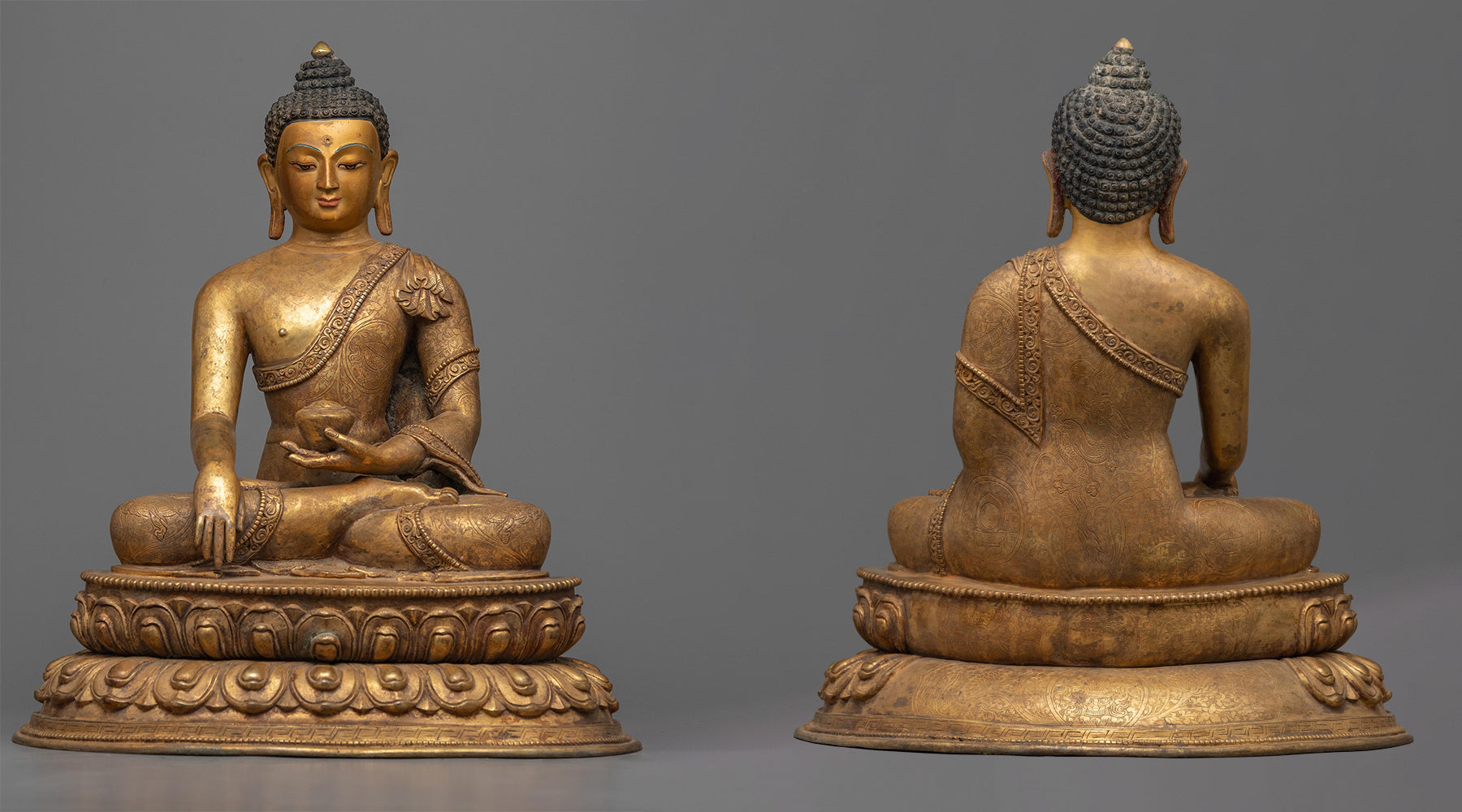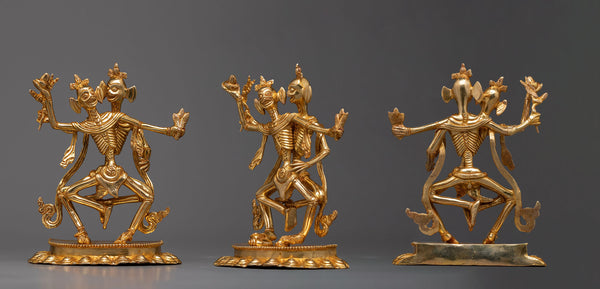Unlocking Enlightenment: Understanding the Four Noble Truths & The Eightfold Path
Buddhism encompasses themes of pain, suffering, balance, self-discipline, wisdom, virtue, karma, rebirth, tolerance, loving-kindness, compassion, non-attachment, meditation, freedom, enlightenment, and Nibbana. These facets converge into a unified and harmonious whole, only to dissipate into nothingness.
If a Buddhist were asked about the teachings of the Buddha, the accurate response would be The Four Noble Truths and the Noble Eightfold Path.
Further inquiry should yield precise definitions of these teachings, devoid of uncertainty, ambiguity, or personal interpretation. It's crucial to ensure that the words of the Buddha remain undistorted, unaffected by ignorance or personal speculation.
Story of Historical Shakyamuni Buddha
Before delving into the teachings, it's essential to explore the life of Siddhartha Gautama, who, through his efforts, attained enlightenment at the age of 35 while meditating under a Bodhi tree.
After achieving Buddhahood, he returned with boundless compassion and loving-kindness. His journey began by sharing his wisdom with fellow ascetics, who had previously abandoned him in the Deer Park near Benares, guiding them to enlightenment.
The Buddha spent the remainder of his life, 45 years, serving humanity by teaching the path to liberation from suffering through selfless love for others. He passed away at 80, accumulating to the laws of nature.
The Buddha, though exceptional being, was merely a human who experienced birth, life, and death like everyone else. He wasn't divine or a god, but through his efforts, he became a flawless model of virtue without supernatural aid.
He guided others toward deliverance through the path of righteousness, emphasizing self-reliance, self-dependence, and self-discipline on the journey to enlightenment.
Core Teachings of the Buddha: Four Noble Truths & The Eightfold Path

The Four Noble Truths and the Noble Eightfold Path encapsulate the core of the Buddha's teachings. The former emphasizes understanding, while the latter stresses practice.
Together, they form an integral structure known as dhamma-vinaya, or simply Dhamma, comprising doctrine and discipline. The sequential relationship between the Noble Eightfold Path and the Four Noble Truths ensures the internal coherence of the Dhamma.
The Buddha's teachings have been pieced together from stories in the Sutta Pitaka. He emerged as a pragmatic reformer who acknowledged the contemporary realities of his time.
Four Noble Truths (Sanskrist: Chatwari Arya Satyani)
-
Sabbam Dukkam: The world is a whole of suffering.
-
Dwadash Nidan: Desire, ignorance, and attachment are the causes of suffering.
-
Nirvana: The suffering could be removed by destroying its cause.
-
Ashtangika Marga: One must know the right path to end suffering- i.e., Eight-Fold Path.
The four noble truths constitute a central teaching in the Buddha's initial discourse after his enlightenment, as depicted in the Vinaya and sutta/sutra literature of early Hinayana schools, preserved in the Pali Buddhist canon.
However, recent scholarship indicates that not all Buddhist schools shared the same emphasis on this teaching as Buddhism spread across India and beyond.
Accounts of Gautama Buddha's enlightenment and inaugural dhamma/dharma discourse are found in the Pali, Mahīśāsaka, and Dharmaguptaka canons, the latter of which are available in Chinese translations.
The first truth, Suffering (Dukkha): The first truth acknowledges the presence of suffering or dissatisfaction in life, encompassing both physical and emotional pain. This suffering is inherent in the cycle of reincarnation.
The Buddha identified various forms of suffering, such as birth, aging, illness, and death, along with experiences like encountering the unpleasant, separation from the pleasant, unfulfilled desires, and the process of birth itself.
The second truth, Origin (Samudaya)
The second truth delves into the origin of suffering, highlighting the role of attachment and desire. It suggests that our cravings, attachments, and lack of understanding contribute to the cycle of suffering.
In his first sermon, the Buddha connected the root cause of suffering to desire or attachment. Other Buddhist texts propose that impure actions (like murder, lying, etc.) and impure mental states (such as desire, hatred, etc.) also lead to suffering.
Additionally, ancient writings describe ignorance as a mental state characterized by a distorted perception of reality, such as mistaking pleasure for pain, beauty for ugliness, permanence for impermanence, and self for nothing.
The third truth: Cessation (Nirodha)
The third truth underscores the possibility of ending suffering. By overcoming craving and attachment, individuals can attain freedom from pain, inner peace, and enlightenment.
The essence of Buddhist teaching lies in aiding individuals to develop a reflective mindset, enabling them to relinquish illusions. It emphasizes observing pain, understanding the nature of desire, and recognizing that suffering arises from attachment to desire.
These realizations are not achieved through mere belief but through deep contemplation. Insights emerge from thoughtful consideration of these truths; they cannot be forced through mere willpower or belief.
The fourth truth, Path (Magga)
In his first sermon, the Buddha outlined the path leading to the cessation of suffering, known as the Four Noble Truths. Similar to the first three truths, the fourth truth comprises three aspects.
The first aspect is the Eightfold Path, also called the Noble Path, which serves as the way out of suffering. The second component involves the cultivation and development of this path. The final insight is that this path has been fully developed.
The Noble Eightfold Path (Ashtangika Marga)

In his teachings, Buddha advocated an eightfold path to alleviate human suffering. By following this path, individuals can attain their goals without relying on the guidance of priests or external influences.
What are the Eightfold path?
- Right view
- Right Speech
- Right livelihood
- Right Mindfulness
- Right aim
- Right action
- Right Effort
- Right Concentration
Buddhism's Astangika-marga, believed to be one of the earliest descriptions of the path to enlightenment, is introduced in what is considered Siddhartha Gautama's first sermon as the Buddha, following his enlightenment.
In this discourse, the concept of the Eightfold Path is presented as a middle way, balancing between the extremes of asceticism and sensual indulgence. The term Astangika-marga, sometimes translated as the "Eightfold Noble Path," also carries connotations of nobility.
- Correct View: Understanding the Truth (Samma Ditthi)
Ideas greatly influence success or failure in life. The "right or correct view" entails accurate Buddhist concepts and understanding. Correct views are cultivated through trust in the
Dharma, a clear grasp of cause and effect, discernment of good and bad karmic consequences, recognition of impermanence, suffering, and emptiness, and dedication to Buddhist teachings. With the proper knowledge and perspective, we can only perceive life and the world accurately and avoid incorrect or biased beliefs and actions.
- Correct Intention/Thought; Purify Your Intentions (Samma Sankappa)
Having the right intention involves reasoning based on principles. In Buddhist teachings, the mind is often likened to a field: positive thoughts are akin to healthy seedlings, while negative thoughts resemble weeds.
Attaining Buddhahood requires eliminating delusion, much like cultivating grains necessitates removing weeds. Therefore, those studying Buddhism should safeguard their thoughts, ensuring they align with the Dharma. To avoid conflicts with others, develop a mind that is open, compassionate, pure, and free from anger.
- Correct Speech: Say nothing that offends others (Samma Vaca)
Speaking kindly is the most effective practice for fostering positive karmic connections with others.
Conversely, language can become a weapon of harm when used maliciously, vengefully, or dishonestly or when employing harsh, divisive, or idle Speech. Buddhist practitioners should use their words to uplift and encourage others to be truthful and compassionate, inspiring confidence and belief in oneself.
-
Correct Action: Work to Improve Others' Lives (Samma Kammanta)

Right Action involves cultivating positive karma through bodily actions, which includes refraining from immoral behaviors such as homicide, theft, and sexual misconduct.
It also entails adopting a healthy lifestyle, including maintaining a balanced food, rest, and water intake, engaging in suitable work, ensuring adequate sleep, and incorporating regular exercise.
- Correct Livelihood; Respect Life (Samma Ajiva)
Living a righteous life involves engaging in honorable work to meet one's needs. This includes avoiding involvement in establishments that partake in human or drug trafficking, such as bars, slaughterhouses, fishing tackle shops, weapons shops, and similar enterprises. Upholding a moral lifestyle, fostering harmonious social relationships, and maintaining emotional cleanliness exemplify correct livelihood.
- Correct Effort; healthy cultivation (Samma Vayama)
Right Effort involves diligence to sustain momentum and focus on advancement. It also entails striving to do what is right while avoiding wrongdoing. This objective is delineated into four aspects in the Great Perfection of Wisdom Treatise:
Cultivating wholesome qualities that have not yet arisen, Enhancing existing wholesome attributes, Preventing unwholesome qualities from arising, Relinquishing unhealthy attributes that have already arisen.
- Correct Mindfulness; thought control (Samma Sati)
Right Mindfulness involves utilizing the "four bases of mindfulness" while maintaining pure thoughts aligned with the Dharma. Just before his ultimate nirvana, the Buddha instructed his followers to contemplate the impurity of the body, the suffering of feelings, the impermanence of the mind, and the non-self nature of phenomena.
By understanding the realities of suffering, impermanence, and emptiness through these four pillars of Mindfulness, one can attain nirvana, which is impermanent, blissful, pure, and embodies a universal Buddha nature.
- Correct Concentration; meditation practice (Samma Samadhi)
Right Meditation aims to cultivate moral character by directing the mind and body towards focused development.
The term "meditation" shouldn't be confined to formal sitting practices alone; any form of meditation that calms the body and mind enhances Concentration, dissipates confusion, and reveals the Buddha nature can be considered as possessing the "correct meditative concentration."
Understanding the Four Noble Truths and the Eightfold Noble Path doesn't inherently make followers noble; instead, it's the practice that defines nobility.
While engaging in the Noble Eightfold Path holds greater significance than merely intellectual understanding, comprehending it fully is still essential for adequate adherence. In reality, the practice contributes to adequately understanding the path.


